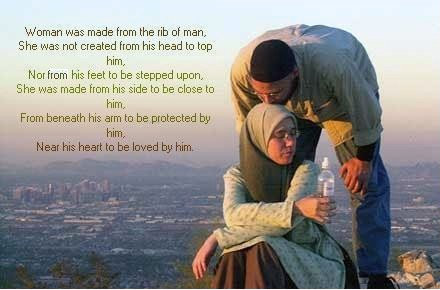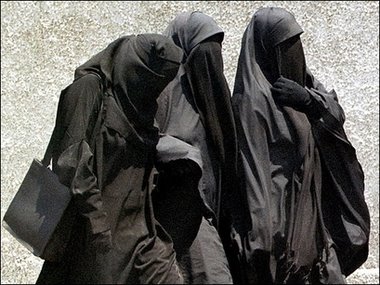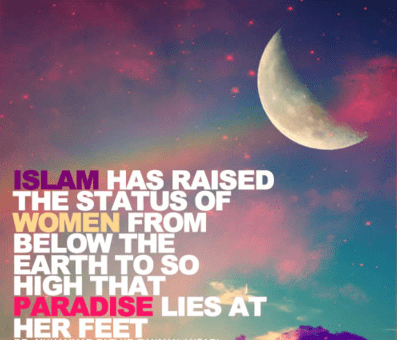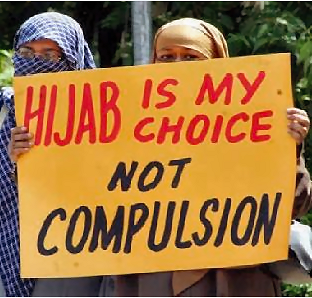Women In Islam Biography
Source:- Google.com.pkThis topic is not a problem for the believers knowing the character of the Prophet, but something that is hard to understand for non-Muslims. Prophet Mohammad (p.b.u.h) has widely been portrayed in the past by orientalists as a lustful man pursuing his lusts and sensuous pleasures, that he was not satisfied with one wife or even four, but married ten or more driven by his desires. But all his wives were elderly ladies or widows except Lady Aisha, whom the Prophet married when she was still a young maiden and Maria (a slave girl, whom he freed and married). If the aim had been seeking sexual pleasures, he would have done so in his youth and would have married young maidens, not aged widows.
First we must remember the life in Arabia in the pre-Islamic time. Due to the tribal wars and blood revenge there had always been a large number widows and orphans who had to be taken care of. This must have been the main reason for polygamy in those days. It was the same ancient custom that was practiced in Palestine in the centuries before Jesus (p.b.u.h.).
Most of the twelve marriages had political or social motives. As it was customary for the Arab chiefs, many were political marriages to cement alliances. European and other world rulers married for the same reason for centuries. Others were marriages to the widows of his companions who had fallen in combat and were in need of protection, since traditionally remarriage was difficult for widows.
As I already mentioned Mohammad was married for 25 years to Khadijah, a twice-widowed lady 15 years older than him. Their marriage was very happy and they had 6 children (4 girls and 2 boys) together and he remained faithful to her until her death.
After 3 years he married a young woman Aisha (p.b.u.h.), with whom he had the closest relationship. The Prophet had spent the prime of his youth with Khadijah. Once Lady Aisha asked the Prophet if Khadijah had been the only woman worthy of his love, he replied in an honest burst of emotion: “She believed in me when none else did. She embraced Islam when people disbelieved me. She helped and comforted me when there was none else to lend me a helping hand.”
Aisha was the third lady to enter the house of the Holy Prophet as his wife. She was the lady, who had the second strongest influence on the Prophet’s private and family life. She was the daughter of his lifelong friend and companion Abu Bakr, who succeeded him as ruler of the Islamic state. Aisha was the most intelligent and the most versed in religion among the “Mothers of the Faithful”; she was even more knowledgeable than the companions. Many of the companions of the Prophet (p.b.u.h.) used to ask her questions regarding religion.
After the death of his first wife Khadijah (65 at the time, p.b.u.h.) the Prophet (at the age of 50) desperately needed a companion . Young Islam was struggling in Mecca and in the same year the Prophet lost also his beloved uncle Abu Talib, who had taken care of him as a child. A woman close to him, Khawlah Bint-Hakeem (wife of one of the Prophet’s early companions) suggested Aisha, if he wishes to marry a young virgin. She was the daughter of his lifelong friend. But if he preferred a more mature woman, there was Sawdah (bint Zama’a), the widow of Al Sakran ibn Amr Al Ansari, an emigrant to Abyssinia in the early years of persecution in Mecca, who died on their way back home. Sawdah turned to the Prophet himself for shelter since her husband had died in the cause of Islam. The Prophet gave her shelter and married her. She was not young (55 years old) nor pretty with a quick and loose temper as it is reported (in the Hadith’s she is described to have been “a fat huge lady” and “a tall lady”). Soon afterwards he married Lady Aisha.
Later after 5 or 6 years he married widows of his companions, also two women war captives as they were integrated in the Muslim society through legal marriages with the believers. Although the Prophet loved Aisha so much, he treated her in the same way as the rest of his wives. The Prophet referred to her as “the mother of the believers”. Aisha was also a fine scholar of Arabic and good orator. When she needed to make speeches, particularly after the assassination of Uthman, the third Khalif, her speeches were of superb literary quality. She was a scholar of broad knowledge and great ability. Lady Aisha died ( p.b.u.h.) at the age of 58 without having any children.
In some sources it is asserted that Lady Aisha was a child when she married the Prophet.
At that time no official birth records existed in Mecca and they did not even have a recognized calendar. They knew that a year is composed of 12 lunar months, each lasting 29 or 30 days, and they dated matters on the basis of major events in their community. Hence, their dating was considerably lacking in accuracy.
In one Hadith (probably the only one) it is suggested that Aisha was only six or seven at the time of her marriage. It is illogical to assert that Khawlah would have suggested a child as a companion for the Prophet, Aisha must have been of marriageable age. Anyway, the marriage took place after 3 years in Medina (after it was first suggested by Khawlah and after the marriage to Sawdah).
More evidence is provided also by one of the earliest authors of Islam, Ibn Ishaq, who writes, that Aisha and her elder sister Asmaa were among the first 80 people in Mecca, who accepted the Prophets call to Islam. He adds as he mentions Aisha, that she was then a young girl. But how old can she have been then? Old enough to be mentioned among the people, who had taken an important step adopting a new religion. Maybe 10 or so? (Adil Salahi: Muhammad, Man and Prophet)
We know, that the time between the first revelation of the Prophet and the migration to Medina (where the marriage to Aisha took place) were thirteen years. So we can say that even if Aisha was only a newborn baby when she became Muslim, she must have been at least fourteen years old at the time of her marriage. The Prophets daughter Fatimah (p.b.u.them) was born when he was 35 years old, meaning that at the time of the marriage to Aisha in Medina she would have been 17 or 18 years old.
According to another account (by Ibn Hajar) his daughter Fatimah was 5 years older than Aisha, meaning that by no means she could not have been younger than 15 or 16 years old at the time of her marriage. How can we believe that the Prophet would have married a girl of 6 years of age, even a girl of 9 years? The whole assertion about the Prophet marrying a six- or nine-year-old child is highly questionable.
It is amazing how the question of Aisha’s age comes up so very often. However, if we regard the sources (the Hadiths) 100% reliable we should also i.e. unconditionally accept the fact that Prophet Mohammad (p.b.u.h.) did cause the moon to split into two.
If anybody of my readers have any other evidence concerning this theme I would appreciate it if you would share it with me. Knowing the circumstances and the character of the Prophet in all other aspects and that he was a father of girls himself and remembering the fact that Aisha was the daughter of his lifelong companion, it can be taken for granted (in my opinion) that she was of marriageable age . It is hard to imagine that the Prophet, who strived to be an example to his followers, would have done such a thing knowing that the believers were encouraged by the Qur’an to follow his example in all aspects. What an uproar it would have caused, in his own family and in the community! I think we would have much more evidence in the Hadith’s about it.
There is no real evidence for that kind of assertion. The only evidence comes from Hadith’s ( Hadith’s = reports about the lifetime of the Prophet, collections dated ca. 250-300 years later). Also in Islam religious duties (like fasting, praying etc.) become obligatory only after a girl reaches puberty. Why should it be otherwise in marriage, a much graver aspect of life?
Islam introduced the right of a girl to choose her husband, a suitable husband can only be suggested by parents or guardians. Until today it was and still is common practice in Arab countries that marriage becomes a matter of discussion only after a girl reaches puberty. As far as I know in Pakistan and India child marriages were common in the past but are banned today by civil law.
Two highly reliable Hadith’s (Muslim): “Abu Hurairah reports that the Prophet (p.b.u.h.) said: ‘A grown-up girl shall be asked permission about herself. If she is silent, it is her permission; and if she declines, there shall be no compulsion on her.’ “
A report from Ibn Abbas states that: “the Prophet (p.b.u.h.) said: ‘A previously married woman is more a guardian for herself than her guardian and a virgin should be asked permission about herself, and her permission is her silence.’”
Many Hadith’s are narrated by Aisha herself about her marriage in general. In one of them she claims, that (according to the Prophet himself) she was the only virgin among the wives of the Prophet.
The only child from all his wives after his first wife Khadijah was born to a Coptic Christian servant girl Maria, whom he married as she was presented to him as a gift from an Egyptian ruler – a son who died in infancy. All other wives remained childless.
The fact that the Prophet did not have more children later on is an indication, that his marriages were more of a sociopolitical nature, to ensure peace between the tribes of Arabia after they were united under Islam.
“There were many war prisoners captured by the Muslims and entitled to security ad protection. They were not killed or denied any human or physical rights. On the contrary, they were helped to settle down through legal marriages to Muslims instead of being taken concubines and common mistresses. That also was another moral burden on Muslims and had to be shouldered jointly as a common responsibly. Here, again, Mohammad carried his share and took some responsibilities by marrying two of those captivities… The Prophet married some women for sociopolitical reasons. His principal concern was the future of Islam. He was most interested in strengthening the Muslims by all bonds. That is why he married the daughter (Aisha) of Abu Bakr, his first successor, and the daughter of Umar, his second successor. It was by his marriage to Juwairiyah that he gained the support for Islam of the whole clan of Bani Al-Mustalew and all their allied tribes. It was by marrying Safiyah that he neutralized a great section of the hostile Jews of Arabia. By accepting Mary the Copt from Egypt as his wife, he formed a political alliance with a king of great magnitude. It was also a gesture of friendship with a neighboring king that Mohammad married Zaynap who was presented to him by the Negus of Abyssinia (today’s Ethiopia) where many early Muslims found refuge. By most of these marriages, the Prophet meant to eliminate the caste system, the racial and national vanities, and the religious prejudices… ” (c. Hamouda Abdul Aati, ‘Islam in Focus’)
Qur’an 33:32 : “O wives of the Prophet! you are not like any other of the women; If you will be on your guard, then be not soft in (your) speech, lest he in whose heart is a disease yearn; and speak a good word.”
In Islam the number of wives for the believers was reduced to four. This was an unheard progress for the rights of women after centuries of unlimited polygamy. The Qur’an does not advocate polygamy, in the contrary it says :
“… then marry such women as may seem good to you, two, three or four. If you feel that you will not act justly, then one.” (Qur’an 4:3)
“You will never manage to deal equitably with women no matter how hard you try” (Qur’an 4:129).
Since equal treatment according to these two verses of the Qur’an is a practical impossibility, we understand that Islam prefers monogamy. Here, like concerning some other issues (i.e. slavery) Islam made concessions to prevailing social practices of that time.
This is a Hadith which makes us smile, and the Prophet (p.b.u.h.) appear very human to us, narrated by Lady Aisha: “Allah’s messenger was fond of honey and sweet edible things and it was his habit that after finishing the ‘Asr’ (afternoon) prayer he would visit his wives and stay with one of them at that time. Once he went to Hafsah, the daughter of Omar and stayed with her more than usual. I got jealous and asked for the reason for that. I was told that a lady in her folk had given her a skin filled with honey as a present, and that she made a syrup from it and gave it to the prophet to drink (and that was the reason for the delay). I said, ‘By Allah, we will play a trick on him (to prevent him delaying so).’ So I said to Sawdah bint Zam’a, ‘The Prophet will approach you, and when he comes near you, say: ‘Have you taken Maghafir (=a bad-smelling gum)? He will say: ‘No’. Then say to him: ‘Then what is this bad smell which I smell on you?’ He will say to you, ‘Hafsah made me drink honey syrup.’ Then say:’ Perhaps the bees of that honey had sucked the juice of the tree of Al-Urfut.’ I shall also say the same. O you, Safiya, say the same.’ Later Sawdah said: ‘By Allah, as soon as he (the Prophet) stood at the door, I was about to say to him what you had ordered me to say because I was afraid of you.’ So when the Prophet came near Sawdah, she said to him: ‘O Allah’s messenger! Have you taken Maghafir?’ He sad: ‘No.’ She said: ‘Then what is this bad smell I detect on you?’ He said: ‘Hafsah made me drink honey syrup.’ She said: ‘Perhaps its bees had sucked the juice of Al-Urfut tree.’ When he came to me, I also said the same, and when he went to Safiya, she also said the same. And when the Prophet again went to Hafsah, she said: ‘O Allah’s messenger! Shall I give you more of that drink?’ He said: ‘I am not in need of it.’ Sawdah said: ‘By Allah we have deprived him (of it). ‘I said to her: ‘Keep quiet!’. “
Women In Islam Islam Facts For Kids Pictures About Religion Wikipedia And History And Beliefs Worksheet On Women Today And Information Images Wallpapers

Women In Islam Islam Facts For Kids Pictures About Religion Wikipedia And History And Beliefs Worksheet On Women Today And Information Images Wallpapers

Women In Islam Islam Facts For Kids Pictures About Religion Wikipedia And History And Beliefs Worksheet On Women Today And Information Images Wallpapers

Women In Islam Islam Facts For Kids Pictures About Religion Wikipedia And History And Beliefs Worksheet On Women Today And Information Images Wallpapers

Women In Islam Islam Facts For Kids Pictures About Religion Wikipedia And History And Beliefs Worksheet On Women Today And Information Images Wallpapers

Women In Islam Islam Facts For Kids Pictures About Religion Wikipedia And History And Beliefs Worksheet On Women Today And Information Images Wallpapers

Women In Islam Islam Facts For Kids Pictures About Religion Wikipedia And History And Beliefs Worksheet On Women Today And Information Images Wallpapers

Women In Islam Islam Facts For Kids Pictures About Religion Wikipedia And History And Beliefs Worksheet On Women Today And Information Images Wallpapers

Women In Islam Islam Facts For Kids Pictures About Religion Wikipedia And History And Beliefs Worksheet On Women Today And Information Images Wallpapers

Women In Islam Islam Facts For Kids Pictures About Religion Wikipedia And History And Beliefs Worksheet On Women Today And Information Images Wallpapers

Women In Islam Islam Facts For Kids Pictures About Religion Wikipedia And History And Beliefs Worksheet On Women Today And Information Images Wallpapers

Women In Islam Islam Facts For Kids Pictures About Religion Wikipedia And History And Beliefs Worksheet On Women Today And Information Images Wallpapers

Women In Islam Islam Facts For Kids Pictures About Religion Wikipedia And History And Beliefs Worksheet On Women Today And Information Images Wallpapers

Women In Islam Islam Facts For Kids Pictures About Religion Wikipedia And History And Beliefs Worksheet On Women Today And Information Images Wallpapers

Women In Islam Islam Facts For Kids Pictures About Religion Wikipedia And History And Beliefs Worksheet On Women Today And Information Images Wallpapers

Women In Islam Islam Facts For Kids Pictures About Religion Wikipedia And History And Beliefs Worksheet On Women Today And Information Images Wallpapers

No comments:
Post a Comment